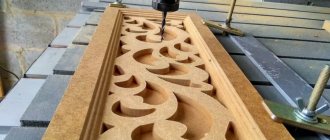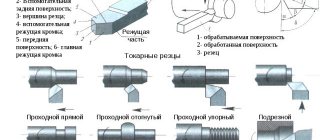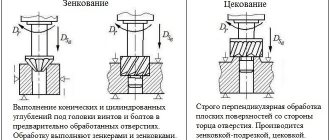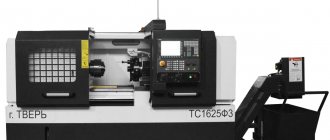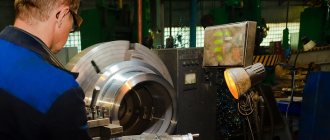Factors affecting machine performance
The choice of appropriate modes depends on a number of factors. For a CNC milling type machine, the most important factors are:
- spindle feed and rotation speed - the permissible rate is calculated depending on the capabilities of the cutting machine, the type of material being processed, as well as the complexity of the part;
- milling width - this indicator is adjusted based on the dimensions of the workpiece (exact data can be found in the drawing);
- milling depth - depends on the number of passes of the cutter (for simple milling on a machine, one pass is usually sufficient);
- cutting speed - the indicator is calculated based on the distance that the cutter travels on wood or other material within one minute (the speed is also set depending on the technical parameters of the workpiece);
- feed – an indicator of spindle movement along three axes;
- feed per minute - calculated to determine the time it will take the spindle to complete the task.
To set up modes and obtain the necessary information, it is recommended to use the instructions for the machine, as well as the permissible values and characteristics of the processed materials in the tables.
High-speed processing of aluminum (HSO)
Aluminum milling is a popular and one of the simplest processing technologies. The installed cutter, removing a layer of metal of a given thickness, gives the workpiece the required shape and dimensions.
The use of modern CNC models ensures guaranteed processing with the most accurate implementation of the smallest elements, obtaining 2D or 3D relief of any degree of complexity. All images are processed in detail and clearly.
The economic efficiency of different technologies can vary quite significantly. VSO is, at the moment, the most effective method of processing aluminum workpieces. This is explained by the fact that a high spindle speed is organically combined with the possibility of increasing (in such modes) the depth of cut. Example. For steel this figure does not change.
In a number of situations, it is more economically feasible to manufacture one part (with a significant percentage of processing waste) than to cut out several parts from the same volume of material. This is precisely what explains the demand for processing VSO modes.
Ways to improve machine efficiency
If you plan to process plastic on a milling machine, it is recommended to use blanks obtained by casting. The melting point of such parts is higher, which reduces the risk of damage during processing. The most optimal mode for cast plastic workpieces is counter milling.
When working with acrylic or aluminum, cutting fluids should be used. The most acceptable option is a universal technical lubricant. If it is missing, you can cool the instrument using ordinary water. Similar requirements for polystyrene.
If the cutter becomes dull during processing of an acrylic part, it is necessary to reduce the speed. Reduction must be carried out before chipping occurs. The lower the speed, the more load the cutting mechanism receives. Therefore, the described task must be performed carefully, otherwise there is a risk of damage to the milling machine. This must be taken into account by those who have previously cut incorrectly.
Subtleties of milling modes
The pliability of Al, contrary to popular belief, does not mean that it is simple and easy to process at any selected cutting conditions, including extreme ones.
There is a high probability of situations occurring, even at moderate milling speeds, when metal shavings tightly clog the grooves of the cutter. The tool fails.
In order to eliminate the likelihood of such situations occurring, the following is required:
- perform work with the “correct” cutters, with the required number of teeth and grooves;
- use coolant;
- correctly select the required milling modes.
All this is achieved, first of all, by strictly following the recommendations of manufacturers of machines and cutters.
One more feature. By default, the definition of “aluminum” is collective. It applies to all alloys produced on the basis of this metal. The specifics of their processing can vary quite significantly.
Example. “Soft” AMG and duralumin require their own processing modes. The latter are selected taking into account existing requirements for the finishing quality of the manufactured part and machine parameters.
Table: cutting speed of materials
| Material | Speed (meters per minute) |
| Aluminum | from 200 to 400 |
| Brass | from 150 to 300 |
| Bronze | from 100 to 150 |
| Bakelite | from 50 to 100 |
| PVC | from 100 to 200 |
| Thermoplastics | from 300 to 500 |
| Various types of wood | from 300 to 500 |
| Stainless steel | from 50 to 90 |
The table contains general values for most machine tools, but they may go beyond the specified scope depending on the modification of the milling machines and the characteristics of the material. For example, plywood has a lower stiffness rating than wood, so standard speed values will not work.
Depth of cut
This is what layer the cutter enters the material. Peculiarities:
- Dependence on density and other characteristics of the workpiece.
- During rough metalworking, the cut-in is large, but during finishing and finishing, a minimal layer is removed.
- The natural limitation is the size of the cutting edge.
A correctly selected parameter determines:
- procedure performance, processing speed;
- appearance and quality of the resulting surface.
It's not always fast - it's as deep as possible at one time. In many cases, it will be more productive to make 2-3 passes to a smaller depth. This will improve the cut and also maintain the integrity of the cutter for a longer period.
Immersion and cutting edge
Milling should be performed using a drilling method similar to drilling. If the end does not touch the material being processed, it is necessary to reconfigure. Due to differences between the edges of the passage, the quality of processing of the sides differs. Recommended:
- mill internal contours clockwise;
- mill external contours counterclockwise.
Thanks to milling using this system, the lower quality side will be cut off.
Important! The deeper the dive, the higher the likelihood of failure. At high speed, the cutter should plunge to a minimum depth, and cutting should be performed in several passes.
Up and down milling
As we noted above, there are two feeds - this is the movement of the cutter itself, as well as the movement of the workpiece. Accordingly, in relation to each other they can be:
- Co-directional. This results in an increased load on the teeth, and accordingly, their wear accelerates. In this case, the power is reduced by an average of 10% of the second type of movement. This is the optimal solution and suitable mode for the finishing stage of metalworking.
- Multidirectional, that is, both feeds (cutter and workpiece) are arranged towards each other. The teeth of the equipment gradually, one by one, cut into the material; it is believed that in this case the mechanical force on each cutting edge is distributed gradually and in proportion to the speed. But this technology is not suitable for the finishing stage of work, because hardening may form during it. This is done at the moment of contact of the cutter with the surface due to the opposite direction. This phenomenon will not only make the cut unsightly, but will also increase the wear rate of the working tool. Therefore, this method is mainly used for primary (roughing) or rough processing.
Heating and Lubrication
As the temperature rises and chips stick, the cutter loses its performance characteristics and works worse. To avoid breakage or damage to wood or other materials, it is recommended to lubricate the operating mechanisms.
Required for use:
- alcohol and special emulsions - when cutting or drilling aluminum and non-ferrous metals;
- soapy water - when processing parts that contain plexiglass.
In this case, it is necessary to control the feed and its speed. Determination of optimal values is carried out depending on the material and its thickness. To configure the desired indicator, use the values from the table.
“It was smooth on paper...”
The unconditional attractiveness of tandem technology, VSO + increased cutting depth, contains its own “fly in the ointment”. This is a problem of increasing vibration. This phenomenon is inevitable and highly undesirable. And it will not be possible to fight it using traditional methods. Ensuring high rigidity of a four-link system, including a machine tool, a fixture for fixing, a processing tool, and a workpiece, is no longer enough.
It is necessary to take into account the harmonic law, according to which the cutter and spindle vibrate. Simply put, it is necessary to take into account, in addition to the static, also the dynamic characteristics of the resulting vibrations.
Example. Theoretical calculations, confirmed by practice, show that HCA machining of Al parts is best performed with an end mill having 3 spiral grooves. An increase in their number reduces the efficiency of chip removal due to a reduction in the cross-section of each groove in proportion to the increase in their number.
The reverse option, reducing their number to 2, also does not work. It will lead to an increase in unwanted harmonics. This is due to the following. The frequency with which the cutter oscillates no longer coincides with the number of blows that a pair of cutting edges make on the part (at spindle speeds reaching 20,000 rpm).
Special software products allow you to evaluate the optimal speed of its rotation. They allow you to evaluate the tonality of the device’s own vibrations. To do this, “listening” of the machine-tool system is carried out. The problem is solved by a specially designed microphone connected to the PC.
Tables: feed speed
| Material | Speed for 3mm face tool (in millimeters per minute) | Speed for 6mm face tool (in millimeters per minute) |
| Soft woods | from 1 to 1.5 thousand | from 2 to 3 thousand |
| Solid wood | from 0.5 to 1 thousand | from 1.5 to 2.5 thousand |
| Double layer plastic | 2 thousand | absent |
| Acrylic and different types of polystyrene | from 0.8 to 1 thousand | from 1 to 1.3 thousand |
| PVC | from 1.5 to 2 thousand | from 1.5 to 2 thousand |
| Aluminum alloys | from 0.5 to 0.8 thousand | from 0.8 to 1 thousand |
The values in the table indicate the minimum and maximum values at which milling machines can cut properly without risk of failure.
General recommendations for cutting modes:
For soft wood (pine, larch, linden)
| Tool type | Working feed mm/min | Rotation speed (rpm) | Depth per pass |
| End 6mm | 2500-3500 | 20 000-24 000 | 7,5-8 |
| End 3mm | 1000-1500 | 20 000-24 000 | 4,5 |
| Engraver 30° * 0.2 | 800-600 | 20 000-24 000 | 3 |
For hard wood (beech, oak, plywood)
| End 6mm 3500 | 4500 | 20 000 — 24 000 | 34 |
| End face 3mm 2500 | 3000 | 20 000 — 24 000 | 2 |
| Engraver 30°x0.2 300 | 600 | 20 000 — 24 000 | 2 |
For two-layer plastic
| End 3 mm | 2000 | 12000 | 0.3 |
| Engraver 30°x0.2 | 2000 | 20000 | 0.3 |
For acrylic and polystyrene
| End 6 mm | 1000 — 1300 | 10 000 — 12 000 | 3 |
| End 3 mm | 800 — 1000 | 12 000 — 16 000 | 1,5 |
| Engraver 30°x0.2 | 300 — 500 | 18 000 — 20 000 | 0,30,6 |
For PVC
| End 6 mm | 1500 — 2000 | 12000 | 8-10 |
| End 3 mm | 1500 — 2000 | 12000-15000 | 4-6 |
Cutter selection
Setting the required modes largely depends on the characteristics of the cutting mill used. The most suitable option is a large diameter solid carbide cutter. It is expensive, but has a number of advantages:
- high accuracy rate;
- high-quality heat dissipation;
- high cutting and feed speed.
For a specific machine model, it is necessary to use cutters made by the manufacturer. Less expensive manual options can only harm the machine tool.
Cutting aluminum on a CNC milling machine
Modern CNC machines make it possible to carry out the aluminum cutting procedure with the highest possible accuracy and quality, giving the sheets the desired shape and required size.
High technological efficiency of the process is ensured thanks to the development of machine tool industry. When performing milling work on cutting aluminum using CNC machines, skills in working with industrial equipment and specific knowledge in metal processing are required. When using technology in production, the owner’s costs for training employees to work in SCADA applications are significantly reduced. To work, it is enough to create codes based on pre-compiled drawings directly on the machine screens. To do this, you only need to correctly set the coordinates and dimensions of the part, as well as the direction of movement of the cutting tool.
The system independently controls the production process, so the finished product is ideal in terms of geometry.
3D milling machine Advercut K45MT/2040
- Power requirements 380V (220V)
- USB 2.2 connection interface
- XY Motion Gear Rack (Helical) / Taiwan
- Height Z, mm 200 (300)
- Dimensions, mm 2150 x 3150
- Drive motors Stepper (optional)
- Control code G code
- Linear guides Linear rail / Taiwan
- Max. processing speed, mm/min 35000
- Spindle power 3.5-7.5 kW, 18000 rpm
- Axes 3
- Spindle cooling Air
- Supported software Type3 Software/France (included, license), as well as ArtCAM, Ucancam, etc.
- Working field 2000 x 4000 x 200 mm
- Resolution, mm 0.01
- Control system DSP0501
- Collet chuck ER25
- Price 1,328,000 rub.
Go to product
Cutting aluminum sheets on computer-controlled machines is a reliable way to ensure high productivity and quality of finished products.
Advantages of the material
Among the advantages of this structural material, experts note several.
- strength;
- ease;
- corrosion resistance;
- low thermal conductivity (this determines its use in the shipbuilding industry);
- high electrical conductivity;
- affordable price.
It is very important to follow the cutting mode. Exceeding its optimal limits results in rapid wear of the cutter. In addition, aluminum blanks (or aluminum alloys) tend to clog the grooves of cutting tools.
The main thing is to take into account the load on the CNC machine, calculating the optimal speed, cutting depth, feed amount, based on the characteristics of the device.
Self-assembly machine
It is also possible to assemble a CNC machine that processes aluminum with your own hands. It can also work on wood, chipboard and MDF, plastic, acrylic and carbon, that is, it will be universally used. One of the options created has:
- working field with dimensions 850x650 and working height along the Z axis – 150 mm;
- on all axes the width of the HIWIN rail guides is 15 mm;
- NEMA 34 motors;
- 1.5 kW air-cooled spindle;
- TBI screw (step 5 along the Z axis, and 10 along the X, Y);
- switching power supplies (70 V for SD, 24 V for CNC);
- Stepmaster v2 board for the CNC unit and Mach3 control program.
The desktop is made of 19 mm thick MDF board. The result is a rigid structure on which duralumin and aluminum workpieces can be processed.
Some craftsmen work on their machine for a whole year, but the experience they gain will allow them to obtain a model with the necessary parameters and, perhaps, in the future, establish their own production of machines that are not inferior in quality to Chinese models. Such a device, which is structurally reminiscent of industrial options, can be easily modified by adapting it to new needs.
Some of the bottlenecks that craftsmen manage to solve include:
- achieving maximum structural rigidity;
- minimizing welding operations;
- use in the manufacture of a rolling metal pipe with a square section of 80 mm;
- casting a frame from artificial stone (it has much lower vibration than cast iron).
Features of working with the material
It is important to pay attention to some points:
- The increased plasticity of aluminum complicates any processing. The main requirement of technologists is compliance with the accepted sequence;
- An incorrect approach to milling increases the risk of damage to workpieces, including at the stage of their fastening. Therefore, preference is given to the vacuum fixation method;
- the material is highly sensitive to various types of vibration, which can contribute to the appearance of defects on the surface;
- special attention is paid to the accuracy of selecting the milling mode and balancing the collet.

